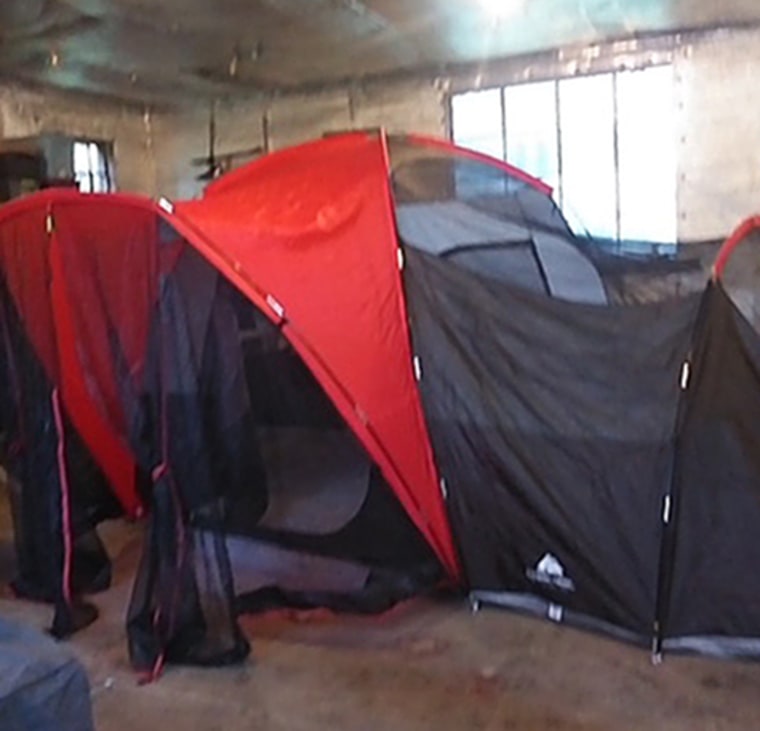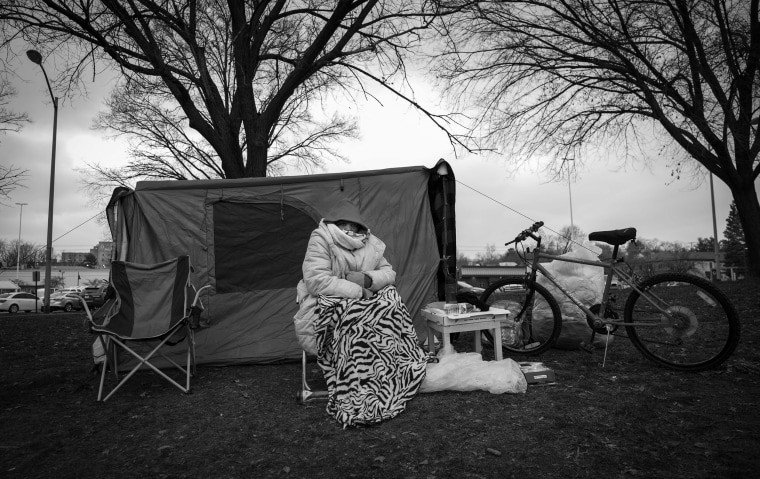To avoid staying at a homeless shelter, Kristie Filippello and her three children have been sleeping on the floor of a relative's one bedroom apartment for nearly two months.
Filippello, 32, left her home after the pandemic caused her housecleaning business to go under and the financial stress of unpaid bills led to abuse from her boyfriend of two years with whom she lived.
With nowhere to go, she and her kids, 6,8 and 11, spent two months at a homeless shelter in Florida before moving to Cincinnati to stay with relatives after getting relocation money from a domestic violence victim's compensation fund in October.
“The coronavirus was spreading, so being in a shelter was not good, plus I have daughters and a shelter is not the right place for any family to be unless it’s an absolute last resort,” said Filippello, who added that she would go to a motel with whatever money she has before returning to a shelter.
She has been trying to get into a government rehousing program but does not qualify because she is living in a home with a family member, even though the arrangement is untenable and she has screened off part of the living room with a sheet divider for her children's privacy and remote schooling.

“When it comes to trying to find assistance, they don’t consider me homeless because I’m not literally on the street and am in someone’s home,” she said. “I feel like I’m in just as much need right now, but very few doors are open for me.”
Homelessness is poised to surge in the coming weeks and months as Americans face continued economic turbulence and a pandemic-inspired eviction moratorium expires later this month. But vital housing assistance may not be fully available to families that don’t meet the U.S. Department of Housing and Urban Development’s definition of "homeless," including those who, like Filippello, have had to double up with other households.
Doubling up is when an individual or family lives with another household temporarily or shuffles indefinitely between homes often because of economic need. People who are doubled up are not considered homeless by HUD, and not allotted certain assistance such as rapid rehousing, housing experts said.
HUD generally defines “homeless” as individuals and families who lack a “fixed nighttime residence,” which includes those living in shelters or on streets. Those who are doubled up, or bouncing between motels, do not fall under this umbrella.
While this exclusion has caused hardships long before the pandemic, rising health concerns and dwindling shelter spaces have hastened efforts to increase housing aid to address the doubled up population, which is expected to swell over the next year.
“With the expiration of the CARES Act moratorium and the expiration of the unemployment insurance benefits, we know that families are already making difficult choices. Even with the CDC eviction moratorium in place, landlords are already filing evictions and using threats to get people to leave,” Eric Tars, legal director for the National Homelessness Law Center, said referring to the Centers for Disease Control and Prevention. “If you have to choose between paying the rent and eating, people are choosing to stop paying rent, and to move in with friends and family, even though it's not where they wish they were.”
What's more, mixing families is risky during the pandemic, he said.
Being doubled up is an “extremely temporary situation” meant for a short period of time, in part because the individual or family has no legal right to the space and can be asked to leave at any time, he said.
But the resolution is not always as simple as going to a shelter, Tars added. Shelter spaces across the country are at reduced capacity to maintain social distancing, leaving fewer options for those in need of a place to stay.
Even before the pandemic, many families avoided going to shelters because of safety concerns and because some facilities separate genders, meaning families are split up. Now, the risk of exposure to the virus is also a drawback. Still, some families are forced to take those risks in order to qualify for homeless assistance, Tars said.
The The Coronavirus Aid, Relief, and Economic Security Act, also known as the CARES Act, dedicated nearly $4 billion in aid to people who are homeless or at risk of becoming homeless as a result of Covid-19. But that amount is a fraction of what is needed to address pandemic-induced homelessness, Steve Berg, vice president for programs and policy for the National Alliance to End Homelessness, said. And because the funds provided are not adequate to assist everyone who needs and is eligible for help, it’s up to local and state officials to decide how much to use for people who are homeless and how much for people who are at risk of homelessness, he said.
“The federal law allows dollars to be used for people who are doubled up if their income is low enough or if they're in a dangerous or unstable situation. But it's up to the local or state government how to prioritize their very limited funding,” Berg said.
Most jurisdictions are applying CARES Act funding under the same guidelines established by HUD, meaning they are using the money to house people who are in shelters or imminently at risk of homelessness, not the doubled up population, said Barbara Duffield, executive director of SchoolHouse Connection, a nonprofit organization that works to overcome homelessness through education.
In a statement to NBC News, HUD said "children and youth and families with children and youth who meet the Department of Education or another Federal Agency's definition of homelessness who don't otherwise meet HUD's definition of homeless are eligible for homelessness prevention assistance under HUD's Emergency Solutions Grants Program."
Download the NBC News app for breaking news and politics
The agency said "homelessness prevention has the same eligible activities as rapid re-housing, which include rental assistance and housing stabilization services. In addition, the CARES Act provided $4 billion to the ESG program, and people who are doubled up and considered homeless by other federal agencies are also eligible for homelessness prevention under that CARES Act funding."
But Duffield said homelessness prevention is usually the last priority for jurisdictions when it comes to HUD dollars.
“Local housing advocates were excited about the CARES Act funding because they wanted to be able to do certain things with it, but their state now essentially says, ‘We're going to follow the federal housing definition,’ so that's a problem for people outside of that,” Duffield said. “Those who are doubled up are not really a priority for some of the prevention efforts, because they're considered to be not at risk or not at great risk.”
Those who are homeless can apply for special housing resources that get them into the housing system, whether it's short term or long term, she said. But people who are doubled up are barred from accessing those options, she said. While there are other avenues and funding that doubled up families do qualify for under HUD, such as homeless prevention grants or if you are at imminent risk of losing housing, those are very small and many times require several additional criteria, she said.
“I think a lot of times when we get into the debate about definitions, people who defend the HUD definition will say, ‘Well, they have a roof over their head. It's OK. They're not at risk. They're not really vulnerable’ but that’s totally untrue.”
Roxann Block and her two children, 9 and 10, shuffle among three different homes in southwest Ohio and northern Kentucky each week because she is not able to get into a homeless shelter near public transportation. After the lockdown, she had to quit her job at a fast food restaurant to stay home with her children who had to do remote learning. She lost her apartment and car over the summer.
Block, 36, now pitches a tent in the garage of the homes of different family members and friends.

“Even though I have a roof over my head, this is not a way for children to live,” Block, who also has been unable to secure housing assistance, said.

But other housing advocates say arguing over who does and does not qualify for homeless funding is a distraction from a bigger issue, which is that housing assistance in general lacks significant funding.
“The real problem is there's all kinds of people who have serious housing problems. And the programs that exist in the federal government, to help people with housing programs are just massively underfunded. And that goes for the CARES Act too,” Berg of the National Alliance to End Homelessness said, adding that it would take $15 billion to provide housing assistance to match the increase in homelessness coming about as a result of the coronavirus.
“HUD has a budget of $50 some billion a year, the homeless programs are less than $3 billion of that," he said. "I feel who gets that $3 billion is not the right question to be asking, the right question is when $50 billion is only a quarter of what's needed to meet the need, why aren't we spending a lot more than that?”
Berg adds that when people, including those who are doubled up, aren’t able to get help, it's not because of eligibility requirements of homeless programs, it is because there isn't enough housing to begin with and the problem will only get worse.
“The number of people who are going to lose housing at the end of the year if the eviction moratorium expires is millions of people, which makes the current level of homelessness look like child's play,” Berg said.
The CDC’s temporary order to halt evictions is set to expire Dec. 31.
“I think the whole lack of treating housing as a basic human need is the crux of the issue,” he said. “It's about housing, decent stable housing. The lack of decent stable housing causes homelessness and it causes lots of other problems too and we need to fix that.”
